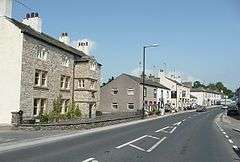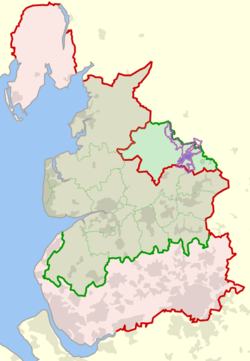Gisburn
| Gisburn | |
 Main Street, showing the former Ribblesdale Arms public house, built 1635 |
|
 Gisburn |
|
| Population | 521 (2011 Census) |
|---|---|
| OS grid reference | SD825485 |
| – London | 190 miles (306 km) SSE |
| Civil parish | Gisburn |
| District | Ribble Valley |
| Shire county | Lancashire |
| Region | North West |
| Country | England |
| Sovereign state | United Kingdom |
| Post town | CLITHEROE |
| Postcode district | BB7 |
| Dialling code | 01200 |
| Police | Lancashire |
| Fire | Lancashire |
| Ambulance | North West |
| EU Parliament | North West England |
| UK Parliament | Ribble Valley |
|
|
Coordinates: 53°55′55″N 2°15′54″W / 53.932°N 2.265°W
Gisburn (formerly Gisburne) is a village and civil parish within the Ribble Valley borough of Lancashire, England. It lies 8 miles (13 km) northeast of Clitheroe and 11 miles (18 km) west of Skipton. The civil parish had a population of 506, recorded in the 2001 census,[1] increasing to 521 at the 2011 Census.[2]
The former spelling of Gisburne was phased out after the introduction of railways in the parish. Gisburn railway station was closed under the Beeching Axe in 1962. Until 1974 Gisburn was in the West Riding of Yorkshire, and Gisburne and similar spellings were also sometimes used for Guisborough, also in Yorkshire (now in North Yorkshire), leading to Gisburn often being referred to as "Gisburn in Craven".
The civil parish adjoins the Ribble Valley parishes of Horton, Paythorne, Sawley and Rimington and the Pendle parish of Bracewell and Brogden.
History

The old Roman road from Ribchester to Ilkley passes to the south of the modern civil parish, with the remains of a 4th-century Romano-British farmstead known as Bomber Camp located just over the boundary with Bracewell and Brogden.[3]
The layout of this linear village, with properties facing the main street and tenement plots running down to a back lane, is common of many established in the tenth century.[4]
Historically Gisburn was part of the West Riding of Yorkshire, within the Deanery of Craven, and Wapentake of Staincliffe. It touched the historic county of Lancashire on the south.
In 1612 a village resident, Jennet Preston, was tried at the Lancashire witch trials, accused of causing the death of Thomas Lister by witchcraft. Her trial took place in York as the village then lay within Yorkshire. Preston was found guilty and was hanged at York Knavesmire.
Markets where held on Main Street until 1911, when the livestock market moved to its present site at the western end of the village next to the former railway station.[4]
In summer 2010, the village controversially featured in a television advertisement for the Renault Mégane.[5]
Ancient parish
Gisburn was the centre of a large ancient parish, which also included the townships of Gisburn Forest, Paythorne, Newsholme, Horton, Rimington, Middop, Nappa and Swinden.[6] All these townships became separate civil parishes in 1866, and all except two became part of Bowland Rural District when it was formed in 1894.[7] Gisburn and the other parishes of Bowland Rural District were transferred from Yorkshire to Lancashire in 1974. Nappa and Swinden became part of Settle Rural District in 1894,[8] and remained in Yorkshire in 1974 as part of the new county of North Yorkshire.
Non-conformism in Gisburn
In 1759 Gisburn established the first place of Methodist worship in the district. On 18 April 1784 John Wesley, then aged 81, preached to a large congregation. The original Methodist chapel on Mill Lane later became part of the village smithy. A new chapel was built in 1871 but closed in 1948 due to falling attendance. The building was then used as a garage and is now the site of three houses known as "The Old Chapel".[9]
In nearby Horton-in-Craven a Congregational chapel was founded in 1670. At Paythorne there is a Wesleyan chapel built in 1830 and in Rimington there is a Congregational chapel dated 1817.[9]
Governance
The civil parish previously had a detached area on the western side of Sawley, with a larger part of that parish on the southern side of Gisburn. In 1938 these areas were joined with the respective parishes.[7]
Along with Rimington, Middop, Gisburn Forest, Paythorne, Newsholme and Horton, the parish forms the Gisburn, Rimington ward of Ribble Valley Borough Council. [10][11] The ward had a population of 1287 in 2001,[12] rising to 1405 in 2011.[13] The ward elects a single councillor, who currently is Richard Sherras of the Conservative Party.[14]
Geography
Gisburn is a rural area, surrounded by hilly and relatively unpopulated areas, with Bowland Forest to the west, Pendle Hill to the south, and the Yorkshire Dales and Pennines not far to the north and east. The relatively flat Ribble valley runs through the parish with the A59 running parallel.
The Pennine Bridleway National Trail and Ribble Way pass through the parish, with former crossing Gisburne Park and the latter following roads through the village. [15][16]
Landmarks
Gisburne Park

To the north of the village, between it and the River Ribble is a 68 hectares (168 acres) 18th-century former deer park and country house, today used as a private hospital, equestrian centre and the Ribblesdale Holiday Park.
The present Grade I listed house, was originally constructed between 1727 and 1736 by Thomas Lister and has been since extended. The Lister family produced a number of Members of Parliament for Clitheroe and later Barons Ribblesdale, and had been previously based at Arnoldsbiggin (Westby Hall). Although the Manor of Gisburne was first acquired by the Lister's in 1614, the family only moved to this site, then called Lower Hall, in 1706. In the mid-18th century, the park was roamed by wild white cattle and deer, and the estate continues outside it, with an unusual tree nursery enclosure known as the ‘Great Nursery’ situated on Coppy Hill to the west. The park is listed in Register of Historic Parks and Gardens and contains a number of notable buildings including the gate lodges at the principal entrance from the village which are listed Grade II*.[17]
The Church of St Mary the Virgin

The ancient church at the centre of the village is dedicated to St Mary the Virgin. It is thought, however, that at one time it also had a dedication to St Andrew, possibly as a deliberate means of avoiding the displeasure of invading Scots. A more likely explanation lies with the one time patrons of the living, the prioress and nuns from Stainfield Nunnery[18] in Lincolnshire, which was itself dedicated to St Mary the Virgin and St Andrew. Indeed, the prioress had a manor house at Rayhead in Gisburn Forest, and the Percy family, who founded the nunnery, were very generous to Gisburn Church. The connection with Stainfield, however, was the source of a bitter dispute between the nunnery and the nearby Sawley Abbey.[9]
Early charters give the priest of Gisburn, between 1140 and 1146, as one Renulf, and it has been suggested that the foundations of the church date from 1135. The large cylindrical pillars at the front of the church are of 12th-century origin. The date of the other pillars is later, perhaps as late as the 16th century, when it is thought that the church was restored. Part of the archway originated from Sawley Abbey following its destruction at the Dissolution.

A further restoration in 1872 involved re-roofing the church, new pews and a new pulpit. Other modifications were also carried out and the work was paid for by a grant from Queen Anne's Bounty, the repayment of which took until 1925.
In the graveyard lies buried one of England's greatest writers of hymn tunes, Francis Duckworth (1862–1941). His most famous tune is "Rimington", to which several hymns including Jesu Shall Reign Where’er the Sun may be sung. The opening lines of the tune are inscribed on his gravestone.[19]
The church is a Grade II* listed building. The south porch has a wide outer entrance with moulded round arch and moulded imposts. The inner door, probably C13th, has a pointed arch with two orders of sunk quadrant moulding. The porch roof has two short king posts rising from collars.[20]
In May 2015 it was announced that a rare King James Version of the Bible, printed in 1611, had been found at the church.[21]
See also
References
- ↑ "Ward populations". Ribble Valley Borough Council. Archived from the original on 19 March 2012. Retrieved 22 March 2016.
- ↑ "Civil parish population 2011". Neighbourhood Statistics. Office for National Statistics. Retrieved 20 January 2016.
- ↑ Historic England. "Bomber Camp Romano-British farmstead (1013817)". National Heritage List for England. Retrieved 17 March 2016.
- 1 2 "Gisburn Conservation Area Appraisal" (PDF). Ribble Valley Borough Council. October 2005. pp. 5–6. Retrieved 27 March 2016.
- ↑ Anger as Renault TV advert pokes fun at Gisburn at lancashiretelegraph.co.uk
- ↑ GENUKI: Yorkshire, West Riding - Gisburn
- 1 2 "Gisburn AP/CP through time". visionofbritain.org.uk. GB Historical GIS / University of Portsmouth. Retrieved 22 March 2016.
- ↑ "Settle RD through time". visionofbritain.org.uk. GB Historical GIS / University of Portsmouth. Retrieved 22 March 2016.
- 1 2 3 "St Mary the Virgin Gisburn History". The Gisburn Village Website. 12 November 2008. Retrieved 12 November 2008.
- ↑ "Gisburn, Rimington". MARIO. Lancashire County Council. Retrieved 22 March 2016.
- ↑ "Gisburn, Rimington". Ordnance Survey Linked Data Platform. Ordnance Survey. Retrieved 22 March 2016.
- ↑ "Parish headcount" (PDF). Lancashire County Council. Archived from the original (PDF) on 10 December 2006. Retrieved 22 March 2016.
- ↑ "Gisburn, Rimington ward population 2011". Neighbourhood Statistics. Office for National Statistics. Retrieved 22 March 2016.
- ↑ "Councillors by Ward: Gisburn, Rimington". Ribble Valley Borough Council. Retrieved 23 March 2016.
- ↑ MKH Computer Services Ltd. "Pennine Bridleway — LDWA Long Distance Paths". Ldwa.org.uk. Retrieved 7 April 2016.
- ↑ MKH Computer Services Ltd. "Ribble Way — LDWA Long Distance Paths". Ldwa.org.uk. Retrieved 7 April 2016.
- ↑ Historic England, "Gisburne Park (1400674)", National Heritage List for England, retrieved 27 March 2016
- ↑ Historic England. "Stainfiled Priory (351572)". PastScape. Retrieved 13 November 2008.
- ↑ "The Life of Francis Duckworth (1862-1941)" at gisburn.org.uk
- ↑ Historic England. "Church of St. Mary, Gisburn (1164472)". National Heritage List for England. Retrieved 9 August 2015.
- ↑ "Rare 1611 'Great She Bible' found in Lancashire church". BBC News. 12 May 2015. Retrieved 23 March 2016.
External links
| Wikimedia Commons has media related to Gisburn. |